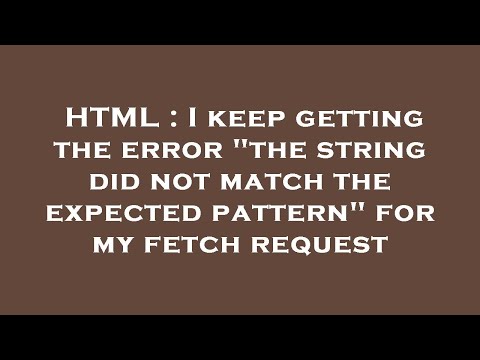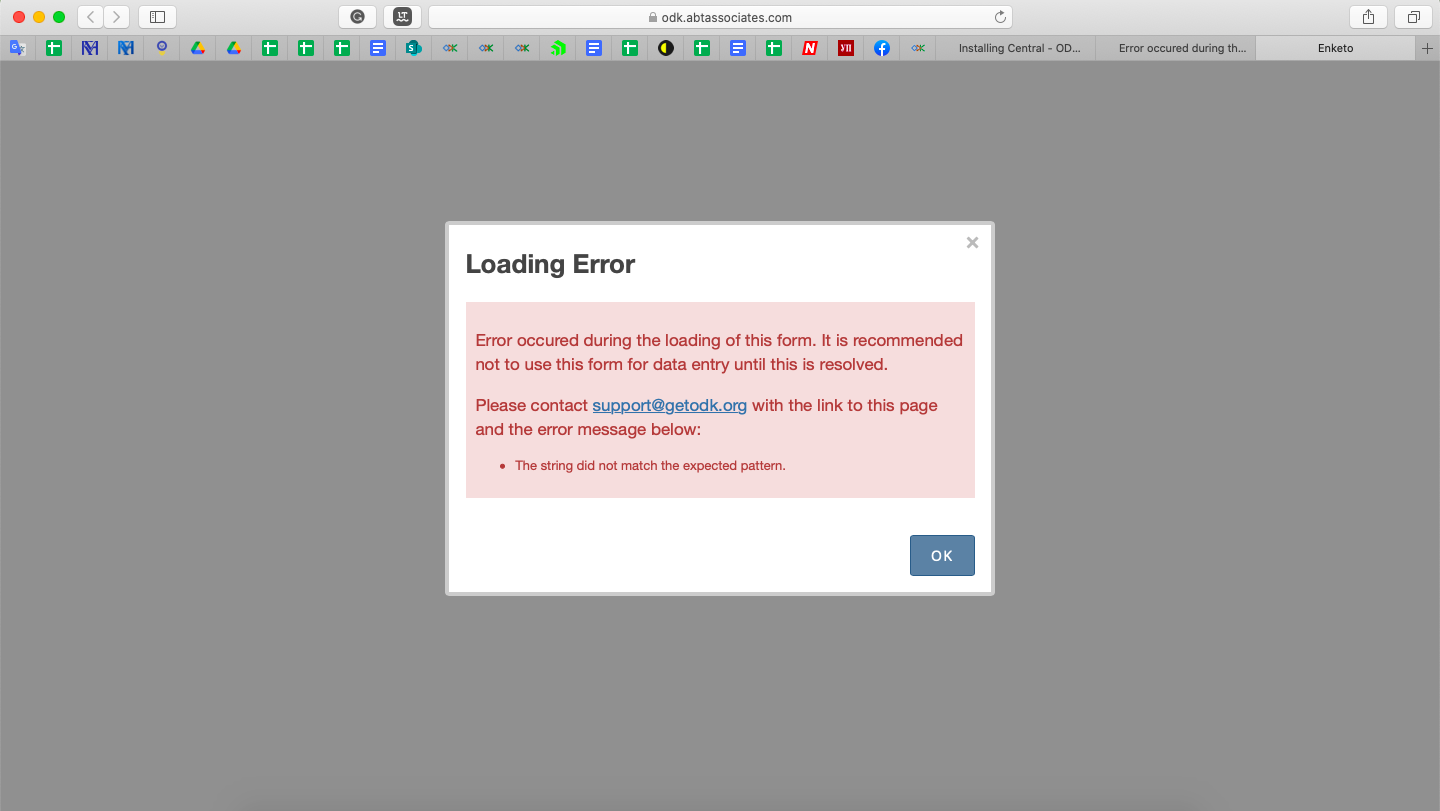The String Did Not Match The Expected Pattern.
String patterns play a crucial role in various aspects of computer programming and data processing. They allow developers to define specific rules and formats that a string of characters must follow. By adhering to these patterns, we can ensure data integrity, improve code readability, and enable efficient data manipulation and analysis. However, encountering a situation where a string does not match the expected pattern can be frustrating and may hinder the intended functionality of an application. In this article, we will dive into the reasons behind mismatched string patterns and explore ways to troubleshoot and resolve such issues.
Identifying Incorrect String Patterns
When a string does not match the expected pattern, it means that it fails to meet the defined criteria. Developers often encounter error messages like “SyntaxError: Unexpected token” or “String does not match the pattern.” These errors act as indicators that the string’s structure or format does not align with what the program or system is anticipating. One such example is the “SyntaxError: Unexpected token DOCTYPE is not valid JSON” error, which notifies that a DOCTYPE declaration is not valid within a JSON file.
Common Causes of Mismatched String Patterns
1. Data Entry Errors: Mismatched string patterns can occur due to typos or errors during the input or retrieval of data. Small mistakes, such as missing or extra characters, can cause the string to deviate from the expected pattern.
2. Improper Formatting: String patterns often rely on specific rules for formatting, such as capitalization, whitespace, or special characters. If these formatting rules are not followed correctly, the string may fail to match the expected pattern.
3. Incorrect Regular Expressions: Developers use regular expressions as a powerful tool for defining string patterns. Any issues with the regular expression syntax or incorrect usage of special characters can result in mismatched patterns.
4. Version Compatibility: String patterns sometimes depend on the version or specification of a particular system or software. If the data is processed on an incompatible version, mismatched patterns may occur.
Evaluating the Expected String Pattern
When encountering a mismatched string pattern, it is essential to evaluate the expected pattern that the string should follow. By understanding the intended format, developers can narrow down potential causes and focus on relevant troubleshooting techniques. In the case of “z0 9 a z0 9 a z0 9 a z0 9,” the expected pattern appears to be a sequence of alphanumeric characters separated by spaces.
Analyzing the Actual String Pattern
To identify the root cause of a mismatched string pattern, analyzing the actual string itself is crucial. Developers should scrutinize the structure, formatting, and content of the string to determine the exact point of mismatch. By identifying any deviations, it becomes easier to troubleshoot and rectify the issue.
Troubleshooting Techniques for Mismatched String Patterns
1. Compare Expected and Actual Patterns: By comparing the expected string pattern with the actual string, developers can pinpoint the differences and understand the specific areas in which they do not align. This comparison is useful for identifying missing or extra characters, incorrect formatting, or missing spaces.
2. Regular Expression Debugging: If the string pattern relies on a regular expression, it is essential to debug the expression itself. Developers can utilize online tools or debugging functions in programming languages to evaluate the regular expression’s behavior and identify any syntax errors or incorrect usage of special characters.
3. Data Validation and Input Sanitization: Implementing robust data validation techniques is crucial for preventing mismatched string patterns. By validating user input and sanitizing it to adhere to the expected pattern, developers can minimize the occurrence of errors. This involves checking for correct formatting, removing unnecessary characters, and ensuring the absence of any potentially harmful data.
4. Debugging and Logging: Developers should keep track of where and when the mismatched string pattern error occurs. By employing debugging techniques and logging relevant information, they can trace the error back to its source and gain insights into the sequence of events that led to the mismatch. This information can be invaluable in identifying and resolving the issue.
Implementing Solutions to Ensure Accurate String Patterns
1. Automated Testing: Creating automated tests that specifically target string patterns can help detect any errors or mismatches early in the development process. These tests can simulate different scenarios and validate the input against the expected pattern, providing feedback to developers and ensuring the accuracy of future changes.
2. Error Handling and User Feedback: Implementing effective error handling mechanisms and providing clear user feedback when incorrect string patterns are encountered can greatly enhance the user experience. By alerting users to mistakes in their input and suggesting corrective actions, developers can reduce frustration and promote the correct usage of string patterns.
3. Version Control and Documentation: Keeping track of different versions of the software, libraries, or systems used for processing string patterns is crucial. Maintaining accurate documentation that outlines the expected patterns and any version-specific considerations can help ensure consistent results and facilitate troubleshooting in future developments.
FAQs
Q: What does “String does not match the pattern” mean?
A: This error message indicates that a string fails to adhere to a specific pattern or format that was expected by the program or system. It suggests that there is a mismatch between the expected and actual structures of the string.
Q: How can I resolve a “SyntaxError: Unexpected token DOCTYPE is not valid JSON” error?
A: This error indicates that a JSON file includes a DOCTYPE declaration, which is not valid within the JSON format. Removing the DOCTYPE declaration or ensuring that it follows the correct syntax should resolve this error.
Q: What are some common causes of mismatched string patterns?
A: Mismatched string patterns can occur due to data entry errors, improper formatting, incorrect regular expressions, or compatibility issues with software versions or specifications.
Q: How can I troubleshoot a mismatched string pattern?
A: Troubleshooting techniques include comparing the expected and actual patterns, debugging regular expressions, validating and sanitizing input data, and implementing robust error handling mechanisms. Debugging tools and logging relevant information can also aid in unraveling the cause of the mismatch.
Q: How can I ensure accurate string patterns in my application?
A: You can ensure accurate string patterns by implementing automated tests, robust error handling and feedback mechanisms, version control and documentation of expected patterns, and adhering to best practices for data validation and input sanitization.
In conclusion, encountering a mismatched string pattern can be a frustrating experience for developers. By understanding the importance of string patterns, identifying incorrect patterns, analyzing the causes of mismatches, evaluating expected patterns, and troubleshooting effectively, developers can implement solutions that ensure accurate string patterns and enhance the functionality of their applications.
Html : I Keep Getting The Error \”The String Did Not Match The Expected Pattern\” For My Fetch Request
Keywords searched by users: the string did not match the expected pattern. SyntaxError: Unexpected token DOCTYPE is not valid JSON, String does not match the pattern of a z0 9 a z0 9 a z0 9 a z0 9
Categories: Top 78 The String Did Not Match The Expected Pattern.
See more here: nhanvietluanvan.com
Syntaxerror: Unexpected Token Doctype Is Not Valid Json
When working with programming languages, encountering errors is a common occurrence. One such error that you may come across is “SyntaxError: Unexpected token DOCTYPE is not valid JSON”. This error is generally related to JSON (JavaScript Object Notation), a widely-used data format for exchanging data between a server and a web application. In this article, we will delve into the details of this error, understand its causes, and explore potential solutions.
Understanding JSON:
Before we dive into the error, let’s have a brief overview of JSON. JSON is a lightweight data-interchange format that is easy for humans to read and write, and for machines to parse and generate. It is primarily used to transmit data between a server and a web application, as an alternative to XML (eXtensible Markup Language).
JSON syntax consists of key-value pairs, where keys are always enclosed in double quotation marks and separated from their corresponding values by a colon. Multiple key-value pairs are separated by commas, and the entire JSON structure is enclosed in curly braces.
Causes of the SyntaxError:
The “SyntaxError: Unexpected token DOCTYPE is not valid JSON” typically occurs when trying to parse a JSON object that contains a DOCTYPE declaration. A DOCTYPE declaration is an instruction that specifies the type of document being parsed by the browser.
Since JSON is a data format, it does not require or support DOCTYPE declarations as they are irrelevant in the context of data exchange. Including DOCTYPE declarations within a JSON object results in a syntax error since it deviates from the expected JSON syntax.
Common Scenarios:
Several scenarios can lead to encountering the “SyntaxError: Unexpected token DOCTYPE is not valid JSON” error. Let’s explore a few common scenarios:
1. Incorrect server response: When making an API request or fetching data from a server, it is essential for the server-side implementation to return a valid JSON response. If the server mistakenly includes a DOCTYPE declaration during the response, attempting to parse the response on the client side will result in the mentioned error.
2. HTML file mistakenly interpreted as JSON: In some cases, a file that should be interpreted as HTML gets mistakenly interpreted as JSON. This can happen if the server does not set the correct Content-Type header for the response, or if the client-side code explicitly specifies an incorrect content type.
Solutions:
Now that we have an understanding of the potential causes, let’s explore some solutions to resolve the “SyntaxError: Unexpected token DOCTYPE is not valid JSON” error:
1. Check server response: If you encounter this error while making an API request or fetching data from a server, examine the response returned by the server. Ensure that it is a valid JSON response without any DOCTYPE declarations. If you find a DOCTYPE declaration, you may need to modify the server-side implementation to exclude it from the response.
2. Verify server Content-Type header: Make sure the server responds with the correct Content-Type header. For JSON responses, the Content-Type header should be set to “application/json”. If it is not set correctly, modify the server-side code to send the appropriate Content-Type header.
3. Handle non-JSON responses: If you encounter a scenario where a file is mistakenly interpreted as JSON, ensure that the server sets the correct Content-Type header for that file. If the server is unable to set appropriate headers, you can enforce the correct interpretation on the client side by specifying the content type in your code. For instance, if the file should be interpreted as HTML, set the Content-Type header accordingly.
FAQs:
Q1. Can I use a DOCTYPE declaration in JSON?
A1. No, DOCTYPE declarations are not valid within JSON objects as they are not part of the JSON syntax.
Q2. Why is parsing JSON important?
A2. Parsing JSON allows the extraction and utilization of data returned from servers. It is essential for client-side applications to interpret and manipulate JSON data effectively.
Q3. Are there any alternatives to JSON for data exchange?
A3. Yes, XML is an alternative to JSON for exchanging data between a server and a web application. However, JSON has gained popularity due to its simplicity, readability, and ease of use.
Q4. How can I debug JSON parsing errors?
A4. To debug JSON parsing errors, examine the network response from the server using browser developer tools. Check if the returned response is a valid JSON object and investigate any inconsistencies or unexpected tokens encountered.
In conclusion, the “SyntaxError: Unexpected token DOCTYPE is not valid JSON” error is encountered when parsing JSON that contains a DOCTYPE declaration. By understanding the causes and implementing the provided solutions, you can resolve this error and ensure smooth data exchange between servers and web applications.
String Does Not Match The Pattern Of A Z0 9 A Z0 9 A Z0 9 A Z0 9
When working with strings, developers often encounter situations where they need to validate the input against a specific pattern. One commonly used pattern is “z0 9 a z0 9 a z0 9 a z0 9”, which refers to a string that starts with any letter from a to z, followed by a digit from 0 to 9, then another letter, and finally another digit. This article aims to explore why a string may not match this particular pattern and address frequently asked questions related to it.
Understanding the Pattern:
The pattern “z0 9 a z0 9 a z0 9 a z0 9” can be broken down into four parts:
1. “z” represents any lowercase letter, ranging from ‘a’ to ‘z’.
2. “0” denotes any digit from 0 to 9.
3. “a” signifies an alphanumeric character, allowing both letters and digits.
4. The pattern repeats three times.
Reasons for the String Not Matching the Pattern:
1. Incorrect Character Input: The most common reason for a string not matching the pattern is inputting an invalid character. For example, if the input contains a special character or a space where it shouldn’t be, it will not match the expected pattern.
2. Length Mismatch: If the string does not contain exactly eleven characters, it will not match the pattern. It’s crucial to ensure that the input has the correct length to fulfill the “z0 9 a z0 9 a z0 9 a z0 9” requirement.
3. Incorrect Sequence: The pattern strictly defines the sequence in which the characters should appear. If a letter is placed where a digit should be, or vice versa, the string will not match the pattern.
4. Case Sensitivity: The pattern expects lowercase letters (‘a’ to ‘z’) as the first, third, and fifth characters. If any uppercase letters are used instead, the string will not conform to the pattern.
FAQs:
Q: Can the pattern be modified to match uppercase letters?
A: Yes, the pattern can be modified to account for uppercase letters by replacing “z” with “Z”. For example, “Z0 9 a Z0 9 a Z0 9 a Z0 9” matches strings with uppercase letters in the specified positions.
Q: How can I validate a string against this pattern in programming languages?
A: Most programming languages provide built-in functions or regular expressions for pattern matching. Utilizing regular expressions, you can create a pattern that matches the given criteria and apply it to the string.
Q: Are spaces allowed within the string?
A: No, spaces are not allowed within the string. The pattern expects eleven continuous characters without any whitespace.
Q: Can the pattern be extended to match a different number of characters?
A: Yes, the pattern can be adapted to accommodate a different number of characters by modifying the repetition count. Additionally, you can also revise the pattern itself to include a different sequence of characters.
Q: How can I handle the situation if a string does not match the pattern?
A: In such cases, developers typically return an error message or handle the input string separately, depending on the requirements of the program or application. It’s essential to communicate the error clearly to users, indicating the expected pattern and the reason for the mismatch.
Q: Is there any specific use case for this pattern?
A: This pattern is commonly used when developers need to enforce certain formatting rules for inputs like passwords, usernames, or identification numbers. By validating against this pattern, developers can ensure that the input follows a specific pattern and meets certain criteria.
In conclusion, the pattern “z0 9 a z0 9 a z0 9 a z0 9” is a commonly used format for string validation in programming. By understanding the pattern and the potential reasons for it not matching the expected criteria, developers can effectively handle and validate user inputs in their applications.
Images related to the topic the string did not match the expected pattern.

Found 42 images related to the string did not match the expected pattern. theme





Article link: the string did not match the expected pattern..
Learn more about the topic the string did not match the expected pattern..
- I keep getting the error “the string did not match the expected …
- [Bug] The string did not match the expected pattern – Safari
- Error: The string did not match the expected pattern – Support
- Issue – The string did not match the expected pattern – Microsoft
- The string did not match the expected pattern – Data Collection
- Unmocking axios? I get ‘the string did not match the expected …
- The String Did Not Match The Expected Pattern
- String does not match expected pattern
- Unmatched String: Understanding The Dpd (Data Processing …